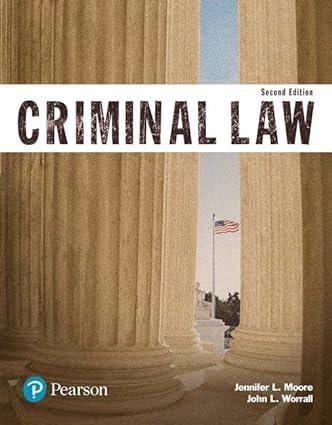In April 2002, Stallings was incarcerated at the Algoa Correctional Center, having served thirteen years of his
Question:
In April 2002, Stallings was incarcerated at the Algoa Correctional Center, having served thirteen years of his twenty-three year sentence for various felony offenses. He worked as a clerk in the prison’s library.
On April 22, 2002, an office assistant in the Algoa records department opened a manila envelope that came from the message center, a room where mail was sorted for delivery to various departments in the prison. The unsealed envelope appeared to have been sent through inter-agency mail from the Fulton Reception and Diagnostic Center.
Among the documents in the envelope was a four-page order, purportedly from the St. Louis County Circuit Court, stating that Stallings’ prison sentence had been reduced to thirteen years. Upon review of the order, Algoa records officer Teresa Adams became suspicious that it was not authentic. Adams noticed the order had no original signatures and the court clerk’s certification on the last page did not include an embossed seal.
Subsequent investigation revealed there was no order in Stallings’ court file to amend or otherwise reduce his prison sentence. The order that arrived in the Algoa records department was determined to be a forgery, with a photocopied signature of the sentencing judge and a photocopied certification seal.
The document was sent to the Missouri State Highway Patrol laboratory for fingerprint testing. Four of Stallings’ thumbprints were found on pages of the forged document.
Stallings was charged with one count of forgery. At the jury trial, the State presented evidence that Stallings, as a clerk, had access to electronic typewriters and a copy machine in the prison library. Library clerks also were permitted to enter the message center without supervision. A Highway Patrol official identified Stallings’ fingerprints on the counterfeit document. A prison official testified that although outgoing inmate mail was generally checked for contraband and inappropriate content an envelope marked as “legal mail” would not be opened unless it was suspected of containing contraband.
. . . Stallings was charged with committing a forgery in violation of Section 570.090, which provides in relevant part: 1. A person commits the crime of forgery if, with the purpose to defraud, he (1) Makes, completes, alters or authenticates any writing so that it purports to have been made by another or at another time or place or in a numbered sequence other than was in fact the case or with different terms or by authority of one who did not give such authority; or . . . (4) Uses as genuine, or possesses for the purpose of using as genuine, or transfers with the knowledge or belief that it will be used as genuine, any writing or other thing which the actor knows has been made or altered in the manner described in this section.
Questions:
1. Which element of forgery is the defendant attacking with his legal argument?
2. How did the prior precedent (prior cases) of Conway and Pride impact the court’s decision?
Step by Step Answer:






